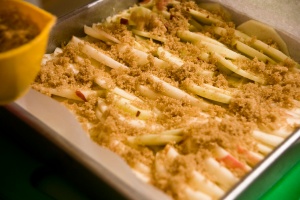The inspiration for this recipe was a leftover ham bone. The only recipe I could find that used ham bone was split pea soup. I am not a huge fan of split pea soup, so I decided to start with Julia Child’s pork stock as a guide (if you have her books, look up the split pea soup, the stock recipe is in there).
I wanted something crunchy and a little rich to go with this light soup. The easy solution is toasted baguette, but I wanted to try something different. The pancetta polenta crouton I settled on goes well is versatile enough to top salads or stand alone as an appetizer. For my next dinner party, I plan to serve the polenta croutons topped with fig butter.
Fresh broth is really different to the canned / boxed broth at the supermarket. I am not against bouillon cubes and boxed stock; those are staples in my pantry. It’s just nice to experience the difference between store bought and fresh.
If you just don’t have time to make your own broth, just substitute in chicken or vegetable stock. I haven’t been able to find a place that carries ready-made, gluten-free pork broth.
If you can’t make your stock within a few days and are worried about freshness of the pork bone (who wants Botulism with their soup), wrap the bones well in parchment paper and a Ziploc bag and stick them in the freezer for up to three weeks.
The Stock:
Ham bone
Onion, quartered
2 stalks of celery, chopped into 3 inch lengths
2 carrots, chopped into 3 inch lengths
herb bouquet: 5 sprigs each rosemary, thyme and parsley
1 large bay leaf
10 cups water

1. Tie the rosemary, thyme and parsley together in a thin layer of cheesecloth. (If you are using a fine strainer at the end, you don’t have to do this, you can toss the herbs into the pot without wrapping them up.)
2. Put the first 6 ingredients in a large stock pot. Add 8-10 cups water. The water should completely or mostly cover the ham bone.
3. Bring to a boil. Stir. Reduce heat to a medium low and simmer for 2-3 hours, stirring occasionally.
 4. Remove from heat. Using a strainer ladle, begin to remove the ham bone, herb bouquet and vegetables. Strain the broth to catch any smaller bits of bone, etc. I normally balance a strainer, lined with cheesecloth on top of another large pot and pour from one pot to another.
4. Remove from heat. Using a strainer ladle, begin to remove the ham bone, herb bouquet and vegetables. Strain the broth to catch any smaller bits of bone, etc. I normally balance a strainer, lined with cheesecloth on top of another large pot and pour from one pot to another.
5. Allow to cool. Skim fat from top with ladle.
Voila! Fresh pork broth.
Soup:
4 cups pork, veggie or chicken broth
2 large onions, thinly sliced
3 small carrots, peeled and diced
1 can cannelloni beans, drained
3 cloves of garlic, diced
2 Tbsp. butter
1 Tbsp. brown sugar
red pepper flakes, to taste
salt and pepper, to taste
Pancetta Polenta Croutons:
4 -5 strips of pancetta
1 cup polenta meal
3 cups chicken broth or water
2 Tbsp. Parmesan cheese
2 stems of rosemary, tough stems discarded and finely chopped
1. In a large soup pot, start to sweat the onions and garlic in butter over medium low heat. After 5 minutes, or when the onions become translucent, add the sugar, chili flakes and a little salt and pepper. Allow the onions to caramelize, about 20 minutes. They should be brown and soft.
2. While the onions are caramelizing, crisp up the pancetta. Over a medium high heat in a dry pan, fry up the pancetta. It should have enough fat that you will not need to add any oil to the pan. When the pancetta is crispy, remove from heat and finely chop.
4. Start the polenta by bringing the broth to a boil. Reduce heat to medium low. Slowly add the polenta meal, stirring constantly. Allow the polenta to thicken, stirring frequently, about 10 minutes. When the polenta is thick, add the Parmesan, pancetta and rosemary. Pour into a 9×9 inch-square pan (I suggest lining the pan with wax paper or saran wrap). The polenta will firm up as it cools.
5. When the onions are well caramelized, add the carrots and cannelloni beans. Turn the heat up to medium high. Cook, stirring occasionally, 3-5 minutes.
6. Add the broth and bring to a boil. When the soup reaches a rolling boil, reduce the heat to medium low and simmer at least 20 minutes.
7. While the soup is simmering, un-mold the polenta. Cut into square or rectangles. I suggest cutting them on the smaller side so you have more crispiness, but then it takes a while to fry off all those squares.
8. Pour grapeseed oil into a medium skillet over high heat. The oil should come up about ¼ inch or so up the side of the skillet. You can tell the oil is hot enough to fry in when a drop of water sizzles in the oil. When the oil is hot, starting add polenta, a few squares at a time. Cook about 2 minutes on a side or until the square is golden brown and crispy.
9. Serve the squares along side the soup, lightly garnished with a little Parmesan. Garnish the soup with finely minced parsley to add some color.













